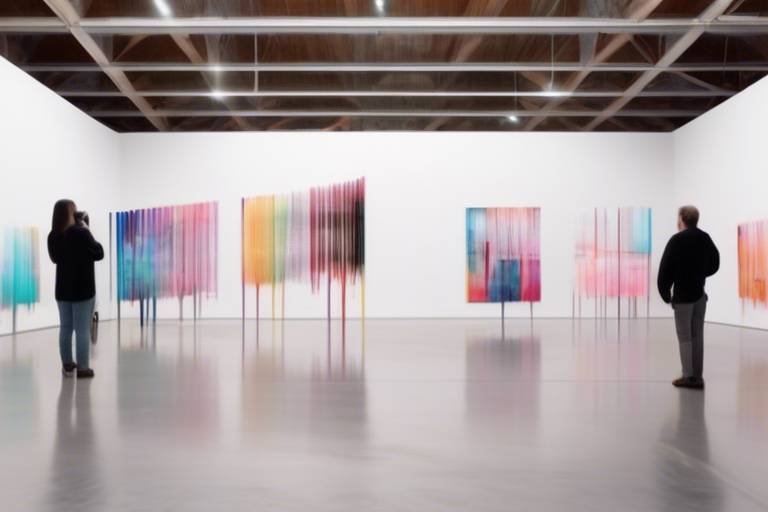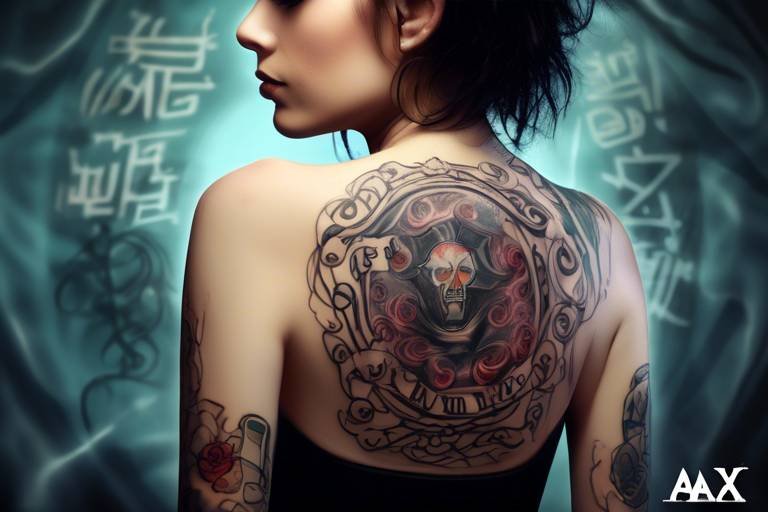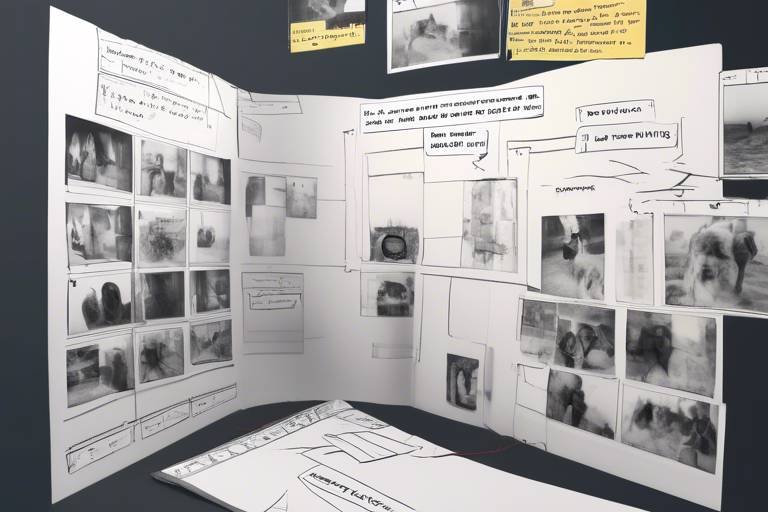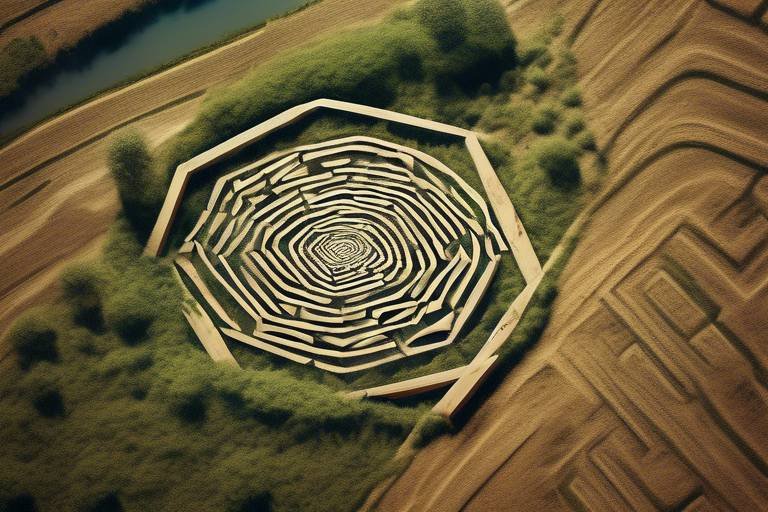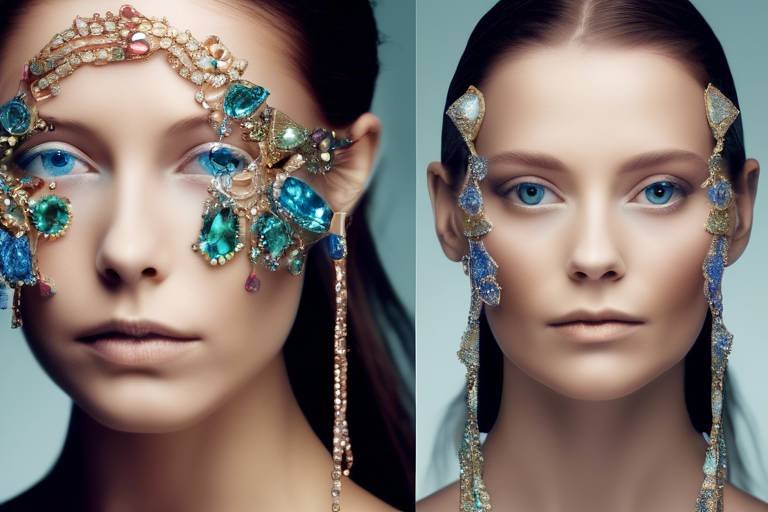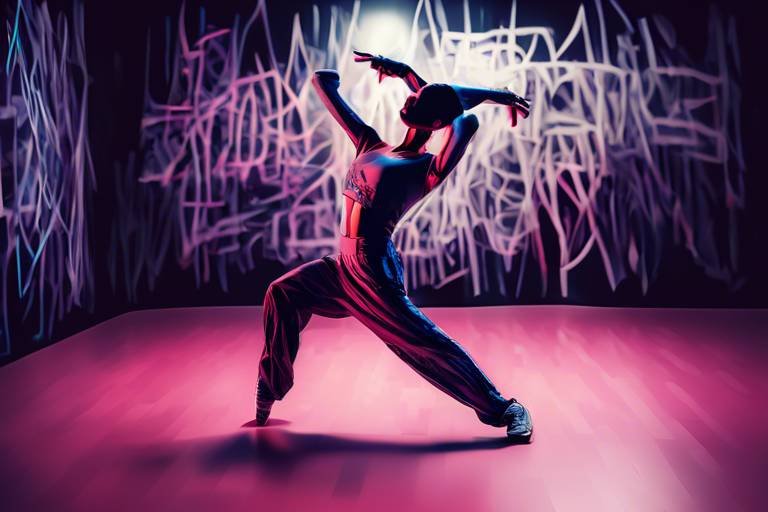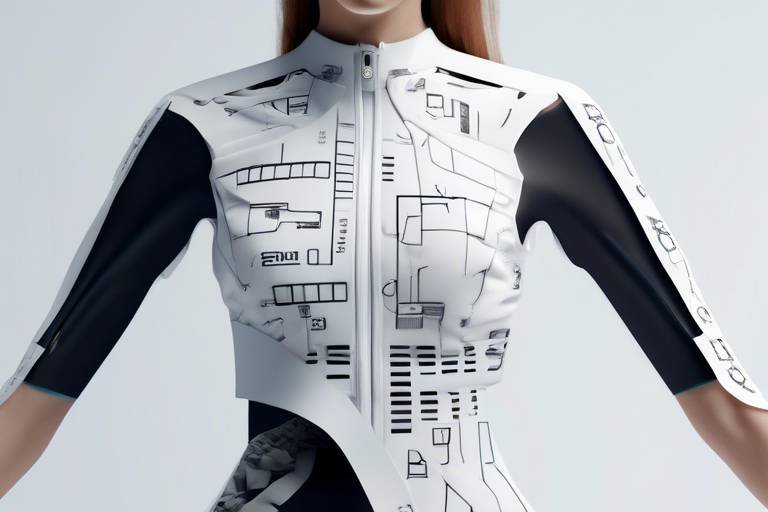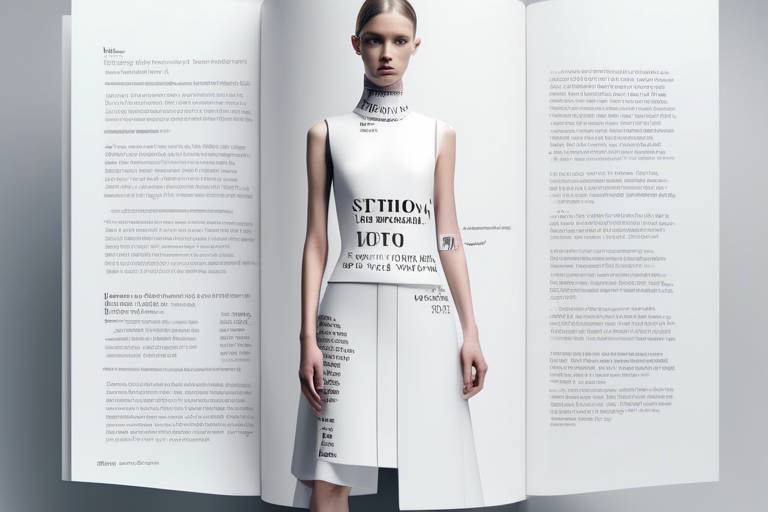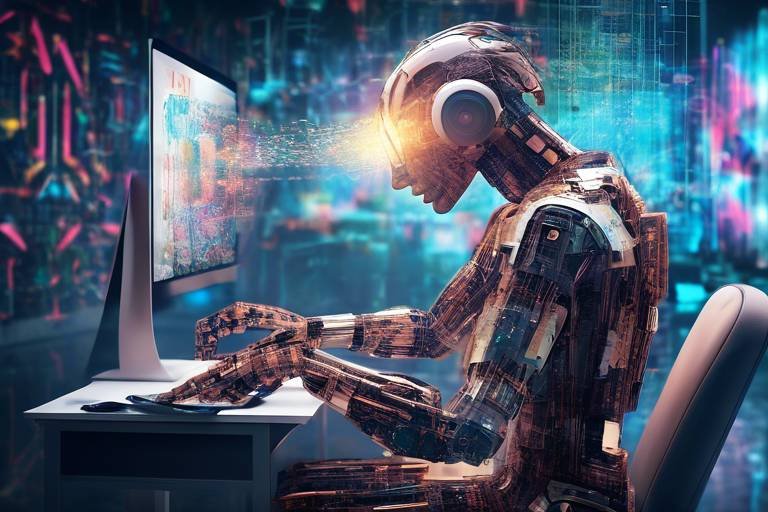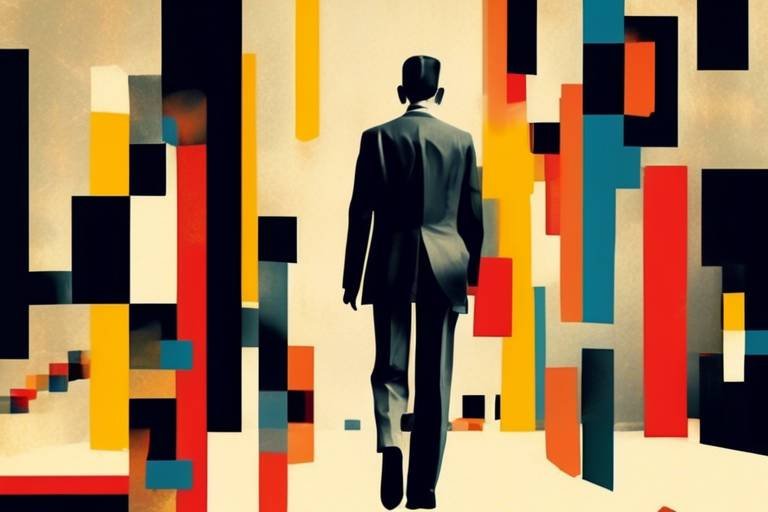Transcending the Norms with AI in Contemporary Art
In an era where technology intertwines with creativity, the art world is experiencing a profound transformation, driven by the remarkable capabilities of artificial intelligence (AI). Gone are the days when artists solely relied on traditional tools and techniques; now, they are embracing AI as a dynamic partner in their creative journeys. This evolution is not just a trend; it signifies a fundamental shift in how art is conceived, created, and appreciated. Imagine a world where a machine can not only assist in the artistic process but also challenge our understanding of creativity itself. This article delves into the intriguing intersection of AI and contemporary art, highlighting how this fusion is reshaping the landscape of artistic expression.
As we explore this captivating realm, it becomes clear that AI is not merely a tool but a catalyst for change. It encourages artists to push boundaries, experiment with new mediums, and redefine what it means to be creative. By analyzing the historical context of AI in the art world, we can see how far we have come and where we might be headed. From early experiments with algorithmic art to today’s sophisticated neural networks, AI has evolved into an essential element of the artistic process.
Moreover, the collaboration between artists and AI brings forth a wealth of possibilities. Artists are no longer confined to their individual visions; instead, they can harness the analytical power of AI to generate ideas, refine techniques, and even produce entire works of art. This collaborative spirit not only enhances the creative process but also invites audiences to engage with art in entirely new ways. As we navigate through the various dimensions of AI in art, we will uncover how this technology is not just transforming the act of creation but also challenging our perceptions of authorship, originality, and the very essence of artistic expression.
As we journey through this article, we will also address the challenges and ethical considerations that arise with the integration of AI in art. Questions about authorship and the implications of machine-generated creativity loom large, prompting artists and audiences alike to reconsider their definitions of art. In addition, we will examine the role of AI in art curation, where algorithms are increasingly being employed to select and present artworks in galleries and museums, further blurring the lines between human and machine involvement in the art world.
Ultimately, the future of AI in art is filled with potential. Emerging technologies promise to deepen the relationship between AI and artistic practices, democratizing access to art creation and appreciation. This inclusivity is crucial as it allows diverse voices and perspectives to flourish, enriching the global artistic landscape. Join us as we explore these themes, uncovering the exciting possibilities that lie ahead in the realm of AI and contemporary art.
- What is AI in contemporary art? - AI in contemporary art refers to the use of artificial intelligence technologies to create, enhance, or curate artworks, challenging traditional concepts of creativity.
- How does AI influence the creative process? - AI acts as a collaborative partner, providing artists with new tools and insights that can inspire and modify their artistic vision.
- What are the ethical concerns surrounding AI in art? - Key ethical concerns include questions of authorship, originality, and the implications of machine-generated creativity on the artistic community.
- Can AI democratize art? - Yes, AI has the potential to make art creation and appreciation more accessible, allowing diverse audiences to engage with artistic expression.

The Evolution of AI in Art
The journey of artificial intelligence in the realm of art is nothing short of fascinating. To truly appreciate its impact, we must first take a step back and explore its historical roots. The seeds of AI in art were sown as early as the 1950s when computer scientists began experimenting with algorithms to create art. Fast forward to the 21st century, and we find ourselves at a remarkable intersection where technology and creativity collide, transforming the artistic landscape in unprecedented ways.
Initially, the use of AI in art was met with skepticism. Many traditionalists questioned whether a machine could ever replicate the emotional depth and human experience embedded in art. However, as technology advanced, artists began to see AI not merely as a tool but as a collaborator. The evolution can be categorized into several key phases:
- Early Experiments: In the 1960s and 70s, pioneers like Frieder Nake and Harold Cohen created algorithmic art, laying the groundwork for future explorations.
- Machine Learning Breakthroughs: The advent of machine learning in the 1980s and 90s allowed computers to learn from data, enabling them to produce more complex and nuanced artworks.
- Deep Learning and Neural Networks: The 2010s witnessed a surge in the use of neural networks, with artists leveraging these technologies to generate unique pieces that challenged traditional notions of creativity.
Today, AI tools such as DeepArt and RunwayML empower artists to explore new dimensions of creativity. These platforms utilize advanced algorithms to analyze and reinterpret existing artworks, enabling artists to infuse their own style into AI-generated pieces. This process not only enhances the creative output but also encourages artists to push the boundaries of their imagination.
Moreover, AI has opened up a dialogue about the very nature of art itself. What does it mean for something to be considered 'art'? Is the emotional connection to a piece diminished if it was created by a machine? These questions are at the forefront of contemporary artistic discourse, prompting artists and audiences alike to rethink their perceptions of creativity and authorship.
As we reflect on the evolution of AI in art, it becomes clear that this journey is not just about technological advancement; it’s about reimagining the creative process. Artists are now equipped with a powerful ally that can augment their vision, challenge their skills, and ignite new forms of expression. The synergy between human creativity and artificial intelligence is a testament to the endless possibilities that lie ahead in the art world.

AI as a Creative Partner
In the ever-evolving landscape of contemporary art, the integration of artificial intelligence as a creative partner is nothing short of revolutionary. Imagine walking into a gallery where the art isn't just displayed but is actively created in collaboration with machines. Sounds futuristic, right? Well, it’s happening now! Artists are increasingly leveraging AI tools not just as assistants, but as co-creators that challenge the very essence of what it means to be an artist.
Think of AI as a brush that can paint millions of strokes in a fraction of a second, or a composer that can generate symphonies based on a few notes you provide. This collaboration allows artists to explore uncharted territories in their work, pushing the boundaries of traditional artistry. For instance, renowned artist Refik Anadol uses AI algorithms to transform data into mesmerizing visual installations. His work, which often involves large datasets, showcases how AI can interpret and visualize information in ways that human artists might not conceive of alone.
Moreover, AI tools can analyze existing artworks, identifying patterns and styles that can inspire new creations. This process is akin to having a brainstorming partner who never runs out of ideas. Artists like Mario Klingemann have embraced this partnership, creating pieces that blend human creativity with machine learning. By feeding algorithms vast amounts of artistic data, they enable these systems to generate unique artworks that reflect a fusion of human and machine creativity.
But how does this creative partnership actually work? Here’s a simplified breakdown:
| Step | Description |
|---|---|
| 1. Input | The artist provides initial ideas, images, or themes to the AI. |
| 2. Processing | The AI analyzes the input and draws from a vast database of existing art styles and techniques. |
| 3. Output | The AI generates new artwork based on the processed information. |
| 4. Refinement | The artist reviews and refines the AI-generated work, adding personal touches. |
This collaborative process not only enhances the artist's vision but also opens up new avenues for creativity. It’s a bit like cooking; while the chef (the artist) has the final say on the dish, the ingredients (AI) can introduce unexpected flavors that elevate the meal to new heights.
However, the journey of AI as a creative partner is not without its challenges. Some artists express concerns about losing their unique voice or the authenticity of their work when machines are involved. Yet, many argue that AI should be viewed as a tool that complements human creativity rather than replaces it. After all, it's the artist's vision, emotions, and experiences that breathe life into the final piece, regardless of how much AI contributed to its creation.
In conclusion, the role of AI as a creative partner in contemporary art is a thrilling frontier that invites both artists and audiences to rethink the nature of creativity itself. As we continue to explore this partnership, one thing is clear: the future of art is not just about the artist alone but also about the dynamic interplay between human ingenuity and machine intelligence.
- Can AI create art independently? While AI can generate artwork, it typically requires human input to guide the creative process and provide context.
- Is AI art considered original? The originality of AI-generated art often depends on the data and algorithms used, raising questions about authorship and creativity.
- How do artists feel about using AI? Reactions vary; some embrace it as a tool for innovation, while others worry about the implications for traditional artistry.

Case Studies of AI-Driven Artworks
As we delve into the fascinating world of AI-driven artworks, it becomes clear that the fusion of technology and creativity is not just a passing trend; it's a revolution. Artists are increasingly embracing artificial intelligence as a tool for innovation, leading to the creation of mesmerizing pieces that challenge our perceptions of art. One standout example is the work of Refik Anadol, whose project titled “Archive Dreaming” employs machine learning algorithms to analyze vast datasets of images, sounds, and videos. The result? A stunning visual experience that transforms static data into dynamic art installations that evolve in real-time.
Another remarkable case is Mario Klingemann, a pioneer in the field of neural networks and AI art. His piece, “Memories of Passersby I”, utilizes a generative adversarial network (GAN) to create an infinite stream of unique portraits. Each face is not a replication of a real individual but rather a composite of learned features, raising intriguing questions about identity and originality in the digital age. This artwork not only captivates viewers but also invites them to ponder the implications of machine-generated creativity.
The Obvious Art Collective made headlines with their AI-generated portrait titled “Edmond de Belamy”, which was auctioned at Christie’s for an astounding $432,500. This piece was created using a GAN algorithm trained on a dataset of historical portraits. The blend of traditional art aesthetics with modern technology provoked a global conversation about the nature of authorship in art. Is the artist the one who programs the AI, or is it the machine itself? This question resonates deeply as we explore the boundaries of creativity.
Moreover, the use of AI in art isn't confined to visual pieces alone. Holly Herndon, an avant-garde musician, uses AI to compose music, collaborating with a vocal AI named Spawn. This partnership results in a unique sound that blurs the lines between human and machine creativity. Herndon’s work exemplifies how AI can be a collaborative partner rather than a mere tool, enhancing the creative process rather than replacing it.
To illustrate the diversity of AI-driven artworks, let's summarize some key case studies:
| Artist | Artwork | Technique | Significance |
|---|---|---|---|
| Refik Anadol | Archive Dreaming | Machine Learning | Transforms data into dynamic installations |
| Mario Klingemann | Memories of Passersby I | Generative Adversarial Network (GAN) | Explores identity and originality |
| Obvious Art Collective | Edmond de Belamy | GAN trained on historical portraits | Raises questions about authorship |
| Holly Herndon | Spawn | AI Music Composition | Collaboration between human and AI |
These case studies exemplify how artists are not merely using AI as a tool; they are engaging in a profound dialogue with technology. Each artwork challenges the viewer to reconsider the essence of creativity and the role of the artist in an era where machines can generate art. As we continue to explore this intersection, it becomes evident that AI is not just a trend—it’s a transformative force in the art world.
- What is AI art? AI art refers to artworks created with the assistance of artificial intelligence, where algorithms and machine learning play a significant role in the creative process.
- Can AI create original art? Yes, AI can generate unique artworks based on learned patterns and styles, but the question of originality and authorship remains a topic of debate.
- How does AI influence traditional art forms? AI encourages artists to explore new techniques and mediums, often leading to innovative fusions of classical and contemporary styles.
- What are the ethical considerations surrounding AI in art? Ethical dilemmas include authorship rights, the potential for plagiarism, and the implications of machine-generated creativity on the human artistic community.

Impact on Traditional Art Forms
The advent of artificial intelligence in the art world is not just a passing trend; it is a revolution that is reshaping traditional art forms in ways that many artists and enthusiasts are still trying to comprehend. Imagine walking into a gallery where the paintings are not merely the result of human creativity but are also influenced by complex algorithms and data-driven insights. This intersection of technology and artistry is prompting artists to rethink their techniques and engage with new mediums, all while striving to preserve the essence of classical art.
One of the most striking impacts of AI on traditional art forms is the way it challenges the very notion of creativity. Traditionally, art has been viewed as a deeply personal expression of the artist's emotions, thoughts, and experiences. However, with AI stepping onto the canvas, there arises a question: Can a machine truly create art? This question fuels a vibrant debate, with some arguing that AI-generated works lack the emotional depth that human artists bring to their creations. Others, however, see AI as a tool that can enhance the creative process, providing artists with new ways to express their visions.
Moreover, AI encourages artists to explore new mediums that were previously unimaginable. For instance, consider how digital art has evolved with the help of AI algorithms that can generate intricate patterns and designs in real-time. Artists can now manipulate these outputs, blending traditional techniques with cutting-edge technology. This fusion not only broadens the scope of what is considered art but also invites a more diverse audience to appreciate and engage with these new forms.
As we delve deeper into the impact of AI on traditional art forms, we can identify several key areas where this influence is particularly pronounced:
- Reinterpretation of Techniques: Artists are experimenting with AI to reinterpret classical techniques, merging them with modern technology to create hybrid art forms.
- Audience Engagement: AI allows for interactive installations where viewers can influence the artwork through their actions, creating a dialogue between the art and its audience.
- Preservation of Techniques: AI can analyze and replicate traditional art techniques, helping to preserve them for future generations while also allowing for innovative adaptations.
In essence, the impact of AI on traditional art forms is multifaceted and complex. It raises important questions about the nature of creativity and the role of the artist in an increasingly automated world. As artists embrace AI as a collaborative partner rather than a competitor, we can expect to see a dynamic evolution in how art is created, perceived, and valued.
As we look to the future, it is clear that the dialogue between traditional art and AI will continue to evolve. Artists who are willing to experiment and adapt will likely find themselves at the forefront of this exciting new chapter in the art world, where the boundaries of creativity are constantly being pushed and redefined.
- What is the role of AI in contemporary art? AI serves as a tool and collaborator for artists, enhancing their creative processes and enabling new forms of expression.
- Can AI create art independently? While AI can generate artworks, many argue that it lacks the emotional depth and personal experience that human artists bring to their work.
- How does AI influence traditional art techniques? AI encourages artists to reinterpret and experiment with traditional techniques, often leading to innovative hybrid forms of art.
- Is AI art considered valuable? The value of AI-generated art is subjective and varies among audiences, but it has gained recognition in galleries and auctions alike.

Challenges and Ethical Considerations
As we dive deeper into the intersection of art and artificial intelligence, it's crucial to confront the myriad of challenges and ethical dilemmas that arise. The rise of AI in the creative realm is not just a technological shift; it’s a cultural revolution that prompts us to reflect on what it means to be an artist in this new age. One of the most pressing questions is about authorship. If an AI creates a piece of art, who owns it? Is it the programmer who wrote the code, the artist who provided the input, or the AI itself? This ambiguity can lead to disputes and challenges in the art market.
Moreover, the concept of originality comes under scrutiny. Traditional art is often celebrated for its unique perspective, the human touch, and the emotional depth that comes from an artist's lived experience. However, when an AI generates art, it does so based on patterns and data it has absorbed, which raises the question: can AI truly create something original? Or is it merely remixing existing ideas? This leads to concerns about the potential for homogenization in art, where AI-generated works may lack the diverse influences that characterize human creativity.
Another significant concern is the impact of AI on the artistic community. As AI tools become more prevalent, there’s a fear that they might replace traditional artists or diminish the value of human-created art. This sentiment is particularly strong among artists who feel that their skills and hard work could be overshadowed by machine-generated outputs. Furthermore, there is a risk of exclusivity, where only those with access to advanced technologies can create and exhibit art, potentially widening the gap between different socio-economic groups.
Ethical considerations also extend to the data used to train AI systems. Many AI models are trained on vast datasets that include copyrighted works, raising questions about intellectual property rights. If an AI generates art based on the styles of famous artists, does it infringe upon those artists' rights? This issue is compounded by the fact that many AI systems operate as black boxes, making it difficult to trace how they arrive at specific outputs. As a result, transparency in AI processes becomes essential to address these ethical concerns.
To navigate these challenges, artists, technologists, and policymakers must engage in ongoing dialogues about the implications of AI in art. Establishing clear guidelines around authorship, originality, and ethical use of data is vital. Moreover, fostering a collaborative environment where human creativity and AI can coexist harmoniously can lead to innovative artistic expressions that honor both traditions and advancements.
- What is the main ethical concern regarding AI in art? The main concerns revolve around authorship, originality, and the potential impact on traditional artists.
- Can AI create original art? While AI can generate art that appears original, it does so by analyzing existing data and patterns, leading to debates on the true nature of originality.
- How does AI impact the art community? AI has the potential to both complement and challenge traditional artists, leading to fears of job displacement and value dilution.
- What role does data play in AI-generated art? Data is crucial as it trains AI models, but ethical use of copyrighted works raises concerns about intellectual property rights.

AI in Art Curation
As we dive deeper into the realm of contemporary art, one cannot overlook the transformative role of artificial intelligence in the curation process. Traditionally, curators have been the gatekeepers of art, carefully selecting pieces that resonate with themes, historical contexts, and audience engagement. However, the advent of AI is reshaping this dynamic, introducing a fascinating blend of technology and creativity that is revolutionizing how we experience art.
AI algorithms are increasingly being utilized to analyze vast databases of artworks, considering factors such as color schemes, styles, and even emotional resonance. This data-driven approach allows for a more nuanced selection process, where AI can identify patterns and trends that might elude even the most seasoned curators. Imagine walking into a gallery where the artworks displayed are not only aesthetically pleasing but also curated based on your personal preferences, thanks to sophisticated algorithms that learn from your viewing habits. It’s like having a personal art advisor who knows you better than you know yourself!
One of the most exciting aspects of AI in art curation is its ability to democratize access to art. By utilizing algorithms that can sift through thousands of pieces, galleries can present a more diverse range of artists and styles. This means that emerging artists, who may have previously gone unnoticed, now have the opportunity to shine alongside established names. The result? A more inclusive art world that celebrates a wider array of voices and perspectives.
Moreover, AI can enhance the visitor experience in galleries and museums. For instance, AI-driven interactive installations can engage audiences in unprecedented ways. Imagine an exhibit where visitors can use their smartphones to receive personalized recommendations based on their interests, or even engage in discussions with AI chatbots that provide insights into the artworks on display. This kind of interaction not only enriches the viewing experience but also fosters a deeper connection between the audience and the art.
However, the integration of AI into art curation is not without its challenges. Questions arise about the authenticity of AI-curated exhibitions. Can a machine truly understand the emotional weight of a piece? What happens to the role of human curators in this new landscape? These questions spark an important dialogue about the balance between technology and human intuition in the art world.
To illustrate the impact of AI in art curation, consider the following table showcasing some notable examples:
| Exhibition | Location | AI Utilization |
|---|---|---|
| “The Next Rembrandt” | Amsterdam | AI created a new painting in the style of Rembrandt using data from existing works. |
| “AI: More than Human” | London | AI algorithms curated artworks based on audience interaction and engagement metrics. |
| “Art and AI” | New York | AI analyzed visitor preferences to create a dynamic exhibition layout that changed in real-time. |
As we look to the future, it’s clear that AI will continue to play a pivotal role in shaping the art curation landscape. The potential for innovation is limitless, with emerging technologies paving the way for even more engaging and personalized art experiences. So, whether you’re a die-hard art enthusiast or a casual observer, the next time you step into a gallery, you might just find yourself marveling at the intersection of art and AI.
- What is AI in art curation? AI in art curation refers to the use of algorithms and machine learning to select, organize, and present artworks in galleries and museums, enhancing the curation process.
- How does AI impact traditional curatorial practices? AI introduces data-driven methodologies that can complement human intuition, allowing for a more diverse and personalized selection of artworks.
- Can AI truly understand art? While AI can analyze data and recognize patterns, the emotional and cultural significance of art is still predominantly interpreted through human experience.
- What are the benefits of AI in art curation? AI can democratize access to art, enhance visitor experiences, and promote a wider array of artists, making the art world more inclusive.

The Future of AI in Art
The future of AI in art is not just a continuation of current trends; it’s a bold leap into uncharted territory. As technology continues to evolve at a breakneck pace, the ways in which artists create, curate, and engage with their audiences are transforming dramatically. Imagine walking into a gallery where the artworks are not only created by human hands but also by algorithms that learn and adapt. This fusion of creativity and technology is set to redefine the boundaries of artistic expression, making the art world more dynamic and unpredictable.
One of the most exciting aspects of AI in art is its potential to enhance creativity. Artists are increasingly leveraging AI tools to push the limits of their imagination. For instance, generative art programs can produce thousands of variations of a single piece, allowing artists to explore possibilities they may never have considered on their own. This collaborative relationship between artist and machine opens up a dialogue about what creativity truly means. Is the artist the sole creator, or is the AI a partner in this dance of imagination?
Moreover, the integration of AI into the art world could lead to a significant shift in how we perceive authorship and originality. As machine-generated art becomes more prevalent, questions arise: Who owns the rights to an artwork created by an AI? Is it the programmer, the artist, or the machine itself? These dilemmas challenge traditional notions of authorship and compel artists and audiences alike to rethink their definitions of creativity and value in art.
Looking ahead, we can anticipate the emergence of new technologies that will further bridge the gap between AI and art. For instance, advancements in machine learning and neural networks are paving the way for even more sophisticated AI tools that can understand and replicate complex artistic styles. Imagine an AI that not only learns from existing artworks but also develops its own unique style, creating pieces that resonate with human emotions in ways we have yet to fully comprehend.
Furthermore, AI has the potential to democratize art by making the tools of creation accessible to a broader audience. With user-friendly AI applications, anyone with a smartphone can become an artist, fostering a culture where creativity is not confined to those with formal training. This shift could lead to a more inclusive art scene where diverse voices are heard and celebrated. As we move forward, the art world may become a vibrant tapestry woven from countless individual expressions, all enhanced by the capabilities of AI.
In conclusion, the future of AI in art is bright and full of possibilities. As artists embrace these new technologies, they will not only redefine their practices but also challenge societal norms surrounding art. The interplay between human creativity and artificial intelligence will undoubtedly create a rich landscape for innovation, pushing the boundaries of what we consider art today. Are we ready to embrace this future, where the canvas is as much a product of human intuition as it is of machine learning?
- What role does AI play in contemporary art?
AI serves as a creative partner, enhancing artistic processes and enabling new forms of expression. - Can AI create original artwork?
Yes, AI can generate unique pieces, although questions of authorship and originality arise. - How is AI democratizing art?
AI tools are becoming more accessible, allowing anyone to create art, regardless of their background or training. - What are the ethical considerations of AI in art?
Issues of authorship, originality, and the impact of machine-generated creativity on the art community are critical discussions.

Emerging Technologies and Trends
As we stand on the precipice of a new artistic frontier, the intersection of technology and creativity is more vibrant than ever. Emerging technologies are not just tools; they are reshaping the very essence of how art is conceived, created, and consumed. From virtual reality (VR) to augmented reality (AR), and the rise of generative adversarial networks (GANs), artists are finding innovative ways to express their visions and engage audiences in ways previously thought impossible.
Consider VR, for instance. It allows artists to create immersive environments that transport viewers into entirely new worlds. Imagine walking through a painting, where every brushstroke is a pathway leading to a different experience. This technology is not just altering the viewing experience; it’s redefining the relationship between the artist and the audience. In this space, the viewer becomes an active participant rather than a passive observer.
On the other hand, AR is enhancing the physical world with digital overlays, allowing art to exist in both the tangible and virtual realms. This blending of reality and imagination opens up a plethora of possibilities for artists to experiment with their mediums. A mural can come to life with animations or interactive elements that engage viewers in a dialogue with the artwork. This trend is pushing the boundaries of traditional art forms, encouraging artists to think outside the canvas.
Moreover, machine learning and AI algorithms are not just tools for creating art; they are also becoming integral collaborators. Artists are leveraging these technologies to generate unique pieces that challenge the notion of authorship and originality. By analyzing vast datasets of historical artworks, AI can suggest styles, techniques, and even themes that an artist may not have considered. This partnership between human creativity and machine intelligence is sparking a revolution in artistic expression.
As we look to the future, the trends indicate a growing emphasis on interactivity and personalization. Audiences are no longer satisfied with static displays; they crave experiences that resonate on a personal level. This leads to an exciting trend where artists are creating customizable artworks that adapt to the viewer's preferences or emotional responses. Imagine a painting that changes colors based on your mood or an installation that evolves based on audience interaction. This trend not only enhances engagement but also democratizes the art experience, making it more inclusive.
However, with these advancements come challenges. The rapid pace of technological evolution means that artists must constantly adapt and learn new skills. Additionally, the question of accessibility arises: while technology can democratize art, it can also create barriers for those without access to the latest tools or the internet. As we embrace these emerging technologies, it’s crucial for the art community to ensure that the future of art remains inclusive and accessible to all.
In conclusion, the relationship between emerging technologies and art is a dynamic and evolving one. As we continue to explore these trends, we must remain mindful of the implications they carry for the future of artistic expression. The canvas is expanding, and the possibilities are endless.
- What role does AI play in contemporary art?
AI acts as a creative partner, helping artists generate new ideas and techniques, often leading to innovative artworks that challenge traditional norms. - How does virtual reality enhance the art experience?
VR immerses viewers in a 3D environment, allowing them to interact with the artwork and experience it from new perspectives. - Are there ethical concerns regarding AI in art?
Yes, questions about authorship, originality, and the implications of machine-generated creativity are significant ethical considerations in the art community.

AI's Role in Democratizing Art
Artificial Intelligence is not just a tool for artists; it’s a revolutionary force that is democratizing the art world like never before. Imagine a scenario where anyone, regardless of their background or training, can create stunning visual masterpieces or compelling narratives. This is the magic that AI brings to the table. With user-friendly applications and platforms powered by AI, the barriers that once stood between aspiring artists and their creative expression are crumbling.
For instance, AI-driven tools such as DALL-E and DeepArt allow individuals to generate artwork simply by entering descriptive text. This means that even those who may have never picked up a paintbrush can now create art that resonates with their emotions and ideas. The process is akin to having a digital assistant that understands your vision and helps you bring it to life. It's not just about creating art; it's about empowering voices that were previously unheard.
Moreover, AI is also playing a crucial role in art education. Online platforms are utilizing AI to tailor educational content to individual learning styles. This personalized approach ensures that learners can grasp complex artistic techniques at their own pace. Imagine a budding artist receiving real-time feedback on their work, helping them to refine their skills and explore new styles without the traditional constraints of a classroom setting.
Another significant aspect of AI’s democratizing influence is its ability to connect artists with audiences. Social media algorithms powered by AI can help emerging artists gain visibility, allowing their work to reach a global audience. This is a game-changer for those who may not have access to traditional galleries or exhibitions. With just a few clicks, an artist can share their work with the world and engage with art enthusiasts who appreciate their unique perspective.
However, while AI is opening doors, it also raises questions about the value of human creativity. Some may argue that machine-generated art lacks the emotional depth and personal touch that human artists bring. But isn't this a fascinating evolution of creativity? Just as photography did not diminish painting but rather expanded the artistic landscape, AI can coexist with traditional methods, pushing boundaries and encouraging collaboration.
In summary, AI is not merely a tool for creating art; it is a catalyst for change that democratizes access to artistic expression. By lowering barriers to entry, enhancing education, and connecting artists with audiences, AI is reshaping the art world into a more inclusive space. As we embrace this transformation, we must also consider how we can best harness AI’s potential while honoring the rich tapestry of human creativity.
- How is AI changing the way art is created? AI tools allow for new forms of artistic expression, enabling anyone to create art through simple commands or prompts.
- Can AI replace human artists? While AI can generate art, it cannot replicate the emotional depth and personal experiences that human artists bring to their work.
- What are some popular AI art tools? Some popular tools include DALL-E, DeepArt, and Artbreeder, which allow users to create unique art pieces using AI technology.
- How does AI impact art education? AI personalizes learning experiences, providing tailored feedback and resources to help aspiring artists develop their skills effectively.
Frequently Asked Questions
- How is AI transforming contemporary art?
AI is revolutionizing contemporary art by introducing new creative processes and tools that artists can utilize. It allows for unique collaborations between humans and machines, enabling artists to explore uncharted territories in their work. This transformation challenges traditional boundaries and inspires innovative forms of expression.
- What are some examples of AI-driven artworks?
There are many fascinating examples of AI-driven artworks. One notable piece is "Edmond de Belamy," a portrait created by a Paris-based art collective using a machine learning algorithm. This artwork showcases how AI can generate visual art that provokes thought about authorship and creativity in the digital age.
- Can AI replace human artists?
While AI can assist in the creative process and generate impressive artworks, it is not likely to replace human artists. The human touch, emotional depth, and unique perspectives that artists bring are irreplaceable. AI serves more as a tool or collaborator, enhancing the artist's vision rather than taking over the creative process.
- What ethical challenges does AI present in the art world?
AI in art raises several ethical questions, such as issues of authorship and originality. Who owns the rights to a piece created by an AI? Is it the programmer, the user, or the AI itself? These questions spark debates about the nature of creativity and the role of technology in artistic expression.
- How is AI being used in art curation?
AI is increasingly being employed in art curation, where algorithms help select and organize artworks for exhibitions. This technology can analyze vast amounts of data to identify trends and preferences, making the curation process more efficient and tailored to audience interests.
- What does the future hold for AI in art?
The future of AI in art looks promising, with potential advancements that could further enhance artistic practices. As technology evolves, we may see more immersive experiences and interactive art forms that engage audiences in new ways. Artists and curators will need to stay informed about emerging technologies to navigate this evolving landscape.
- How can AI democratize access to art?
AI has the potential to democratize access to art by making tools for creation and appreciation more accessible to diverse audiences. With AI-powered platforms, anyone can experiment with art-making, breaking down barriers and encouraging a broader range of voices and perspectives in the art world.

